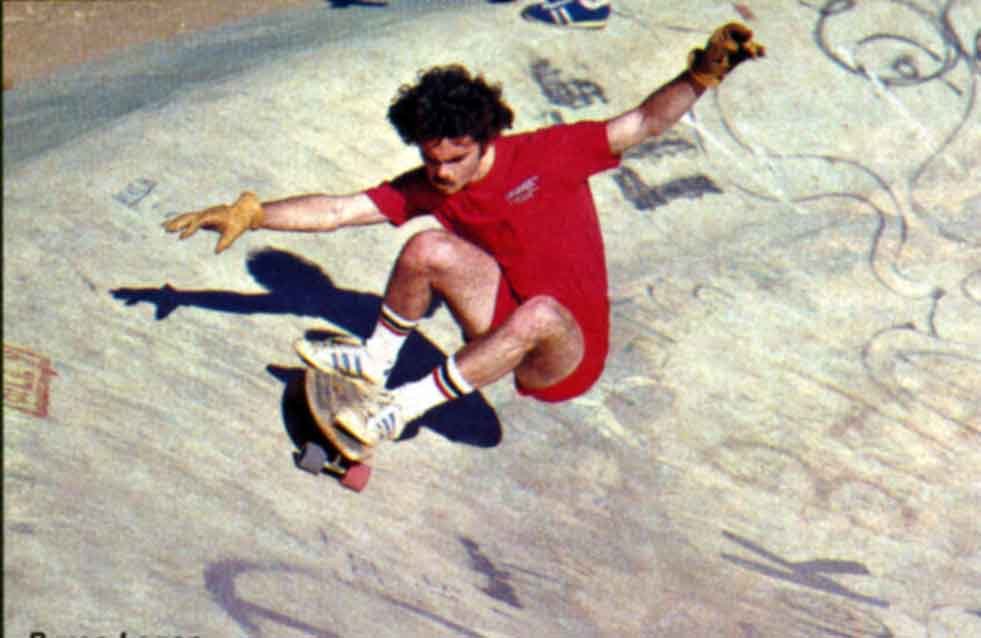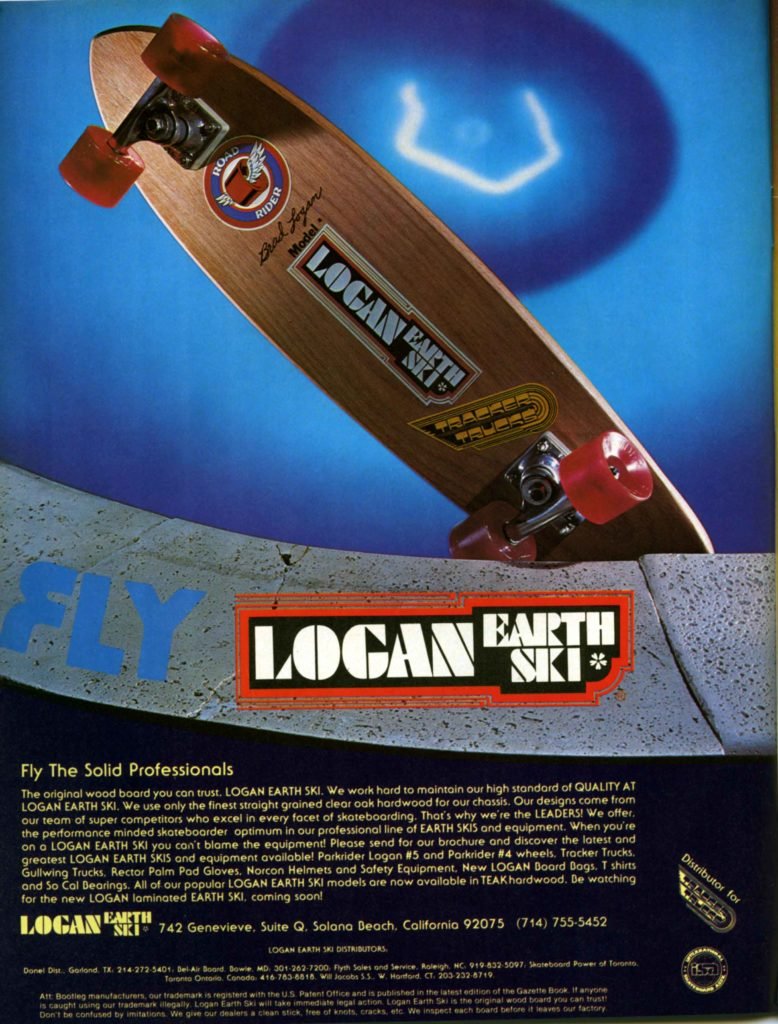The Logan Family, First Family of Skateboarding
The Logans at the La Costa Reuion. Photo: Jim Goodrich
The Logan Family during their interview in the Balma Barn. Photo: Lance Smith
Logan Family Interview
Back in the mid-1970s, The Logans were the first family of skateboarding. At the time, you couldn’t pick up a skateboard magazine without seeing a photo of Bruce, Brad, Brian, or Robin. Raised in Hermosa Beach, California, they started skating in the late 1950s and early ’60s and went on to influence the sport in myriad ways. Read on for a little peek into their lives and times. —GSD
Did you guys have a team back in the ’60s?
Bruce: Yes, we did. It was called the South Bay Skateboard Club. My older brother and I started it. He was the manager of it. Then we got familiar with Bing Surfboards on Pacific Coast Highway and they sponsored our skateboard team.
How did you get hooked up with Makaha?
Bruce: The Makaha team was doing a skateboard demo on the strand and some of the people from our team were skating there and the Makaha guys noticed me first. They gave me one of their boards. I really liked how it maneuvered; it worked well on tricks. I loved the board and liked everybody on the team, so they asked me if I would like to skate for Makaha, and I said sure. One of my dreams as a little boy was to ride for Makaha skateboards.
Bruce Logan before he rode for Tracker Trucks.
When did you move down to San Diego?
Brian: I moved down first in 1969. My siblings and mom moved down in 1973. I left skateboarding in ’66, because it just went dead. Except for Bruce, I didn’t know of anyone who really skated during a two or three-year period in there. There probably was, but very few. Bruce was making skateboards under the label Sunset Skateboards.
So, Bruce, you stayed up there skating with the Makaha guys all the way into the early ’70s.
Bruce: Yes, I did. It was fun. I couldn’t give it up, because I loved it so much.
You guys were skating La Costa when we were prototyping Tracker trucks. When did you get your first Trackers?
Bruce: In 1975, when Trackers first came out to La Costa, we were there first, so seniority counts. Dave Dominy gave me a set of Trackers for my board to bomb the Black Hill on a nose wheelie at 40 miles per hour.
Brian: I was the first one approached by Dave Dominy. Skateboarding had been back with the urethane wheels maybe a year. I was walking up the hill and this guy approached me from the side with a skateboard with these wide trucks. He said, “Mr. Logan, would you try out my skateboard with my new trucks?” I looked at them; they were the Tracker Fultracks. At the time, they were wide. They were so wide, it was like you were standing on a train.
Brad Logan. Photo: Warren Bolster
Brad: I remember Torger Johnson rode Dave Dominy’s board and he loved it. He was doing all kinds of tricks like nose wheelies. The balance, stability and the safety of Trackers increased Torger’s skating tenfold. That’s when he started doing a lot more tricks, nose wheelies, spacewalks and stuff like that. Then he started appearing in some of the very early Tracker ads.
Brian: After that day, I tried Trackers. Other people noticed that they were bizarre-looking trucks, compared to what we were riding. Not too long after, Dave said, “These are getting ready to go into production.” I said, “I want some of those trucks.” Then I designed a skateboard with cut-out wheel wells. I think it was probably the first one, because we didn’t have trucks like this. With that board, I was ready for those Tracker Trucks the day they came out.
Robin: That was our slalom board.
Brian: Yes. I think it was one of the very first, if not the first, cut-out skateboards, because we didn’t have those in the ’60s. We may have raised them a little, bit but we didn’t have cutouts.
Which Tracker truck models did you end up riding the most?
Bruce: My favorite always was and always will be the Fultrack, even though I don’t ride anymore. I had my place in the sun. I skated for 54 years, and I’d had enough. I accomplished everything I ever wanted to, and more than I ever imagined. I don’t compete anymore, and the love of riding doesn’t turn me on anymore. I’ve got other hobbies, like walking my little Ringo.
Robin Logan. Photo: Warren Bolster
Robin: I was a Haftrack rider, because I loved freestyle.
Brian: I liked the Fultrack, because I liked slalom back then. Then I really liked the Midtrack when it came out.
Did you ride that in slalom, too?
Brian: No, I stuck with the Fultrack. I had to keep up with Henry Hester and those guys. I was always two-tenths to three-tenths of a second behind him, but I was close. I was on a wood board; which wasn’t fair, because they were pumping those flexible boards. But, it was all fun.
Brad: I had three boards set up. I had a 32” Torger Johnson with Fultracks for the Concourse. I used to go down there with Torger and Tony Alva and skate all night long. The trucks and the size of the board worked really great. You could just carve, go back and forth and go all the way down, then jump back on the elevator and go all the way back up. We never got hassled at all. I also had a 29” diamond tail with Haftracks and another 29” with Midtracks. Those boards had the wheel wells sanded out.
Brad Logan. Photo: Lance Smith
Did you guys invent any tricks on Trackers?
Bruce: Yes, I did. The nose to tail wheelie, and the forward high pirouette in the air. Everybody else did them backward, but I did them forward. A kickturn in the air. Torger Johnson called it the space walk. I don’t want to take anything away from him, but I was the first one to do the kickturn in the air. That’s what I called it. Torger got credit for the space walk. He and I did it all the way up the hill at a skateboard contest in Santa Barbara in 1975, swinging left to right on your dial.
Robin: My first kickflip and my two-boarded kickflip were on Trackers. I was supposedly the first girl to do a kickflip. There were no other girls out there flipping boards around like I was.
Who did the first nose wheelie?
Bruce: At the Santa Monica Sports and Arts Festival at the Santa Monica Civic, my brother Brian did a nose wheelie the whole length of the concrete floor. But, John Freis invented the nose wheelie and I took it even further to 360s, 720s and 1080s. I would hold it all the way down to the bottom of the Black Hill at 40 miles per hour or faster.
Brian Logan, Black Hill, La Costa, California. Photo: Warren Bolster
Brian: In those early days, there was a time when I was doing longer nose wheelies than Bruce. But, then he took it over and became the king. Just like skateboarding has always gone to the next person and the next level.
Tell us about the worst wipeout you ever saw.
Bruce: The worst wipeout by far scared the shit out of me. Steve Piccolo drove the Logan Earth Ski team station wagon up the hill at La Costa at 50 miles per hour. My older brother Brian was holding onto the door handle, wearing only shorts and tennis shoes. He got the high-speed wobbles and slid up the pavement on his stomach like a baseball player over home plate. He got road rash all over his body.
Bruce Logan. Photo: Chuck Edwall
Why was Tracker so important in the history of skateboarding?
Brian: They changed the way skateboard trucks were made from day one. Nobody changed trucks like Tracker from the way they were in the ’60s going into the next generation. They were so durable and they didn’t break, unlike some of the other trucks out there.
Brad: They changed it in all terrain: flat, slalom, vertical and pipes. You could climb the side of pools much more efficiently with Trackers because of the way they pivoted.
Robin: The Escondido reservoir was the best with them. The rough terrain and going around the bowl, it was true surfing.
Logan Earth Ski ad 1977
Do you recall any memorable times with the Tracker team?
Brian: A lot of the Tracker team came around during the latter part of our involvement in the industry. I remember Russ Gosnell was one of the very early ones, but we were starting to fade out of the industry while you guys kept adding more people.
Brian: The 1970s changed skateboarding forever. That was the generation who defined what skateboarding is now with the products. The trucks made now are still very similar to the original Trackers, and the wheels are still urethane—that hasn’t changed.
Di Dootson refers to the ’70s as the golden years of skateboarding.
Robin: These guys wouldn’t be who they are today if it wasn’t for what was done in the ’70s. The Tony Hawks and the Rodney Mullens have taken it, launched it and grown from it. In my conversations with Rodney, he said he looked at the magazines in the ’70s and saw my brother Bruce do something, which inspired Rodney to do something else with it. He took a nose wheelie and threw it into a heelflip, etc. and look what the guy does now. The ’70s was the launching pad for skateboarding.
Bruce: Don’t forget about us ’60s guys, because skateboarding actually started through surfing. It was something we would do on weekends when the surf was flat so we could practice our style. We wanted to be better surfers and skateboarding was something we just did. Years later, you had surfers flying out of waves. They took that from skateboarding and added it into surfing. We kind of patted each other’s backs from the ’60s to now.
Logan Brothers Bruce and Brian. Photo: Grant Brittian
Dave McIntyre, Robin Logan, and Kim Cespedes. Photo: Grant Brittian










